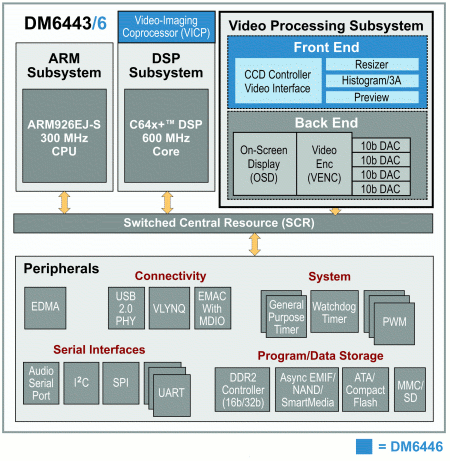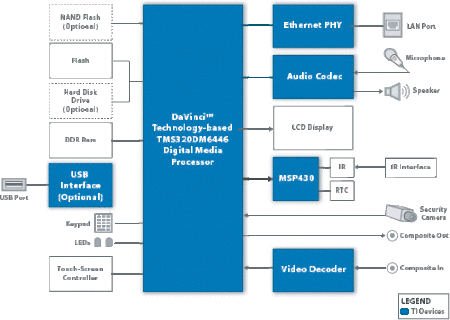Videophone reference design runs Linux
Mar 24, 2006 — by LinuxDevices Staff — from the LinuxDevices Archive — 4 views A codec specialist in Bangalore, India is shipping an IP videophone reference design based on Linux and a Texas Instruments Davinci TMS320DM6446 RISC/DSP SoC (system-on-chip). The IPVP6446 design targets home and enterprise video phones, media centers with videophone capabilities, and video conferencing equipment for… SMBs (small- and medium-sized businesses).
A codec specialist in Bangalore, India is shipping an IP videophone reference design based on Linux and a Texas Instruments Davinci TMS320DM6446 RISC/DSP SoC (system-on-chip). The IPVP6446 design targets home and enterprise video phones, media centers with videophone capabilities, and video conferencing equipment for… SMBs (small- and medium-sized businesses).
(Click for slightly larger view of IPVP6446 ref. design)
The IPVP6446 includes a “Linux platform support package” and interprocess communication technology for TI's Davinci chip, a high-integration SoC for video-enabled mobile devices. The Davinci SoC integrates a 300MHz ARM926J-S core with a 600MHz VLIW (very long instruction word) C64X+ DSP (digital signal processor) core.

Davinci function block diagram
In addition to a Davinci processor, the IPVP6446 design uses TI's MSP430, a 16-bit RISC microcontroller, to monitor the infrared (remote control) port, and to provide a real-time clock. The MSP430 offers “the industry's lowest-power real-time clock mode operation, at 0.8 micro amps,” Ittiam says.

IPVP6446 reference design diagram
(Click image for slightly larger view)
The IPVP6446 design includes 32MB of NOR flash, 64MB of NAND, and 256MB of DDR RAM. The design supports VGA (640 x 480) LCD modules, a CCD (charge-coupled device) camera module, component and S-video out, RJ11 handset port, speaker, microphone, lines in and out, S/PDIF digital audio out, and composite video I/O ports. The design also supports 10/100 Ethernet, integrated Ethernet switch, WLAN, SD/MS/MMS card and SmartMedia sockets, and USB master and slave ports. Supported user interfaces include keypads, IR, PS/2 input devices, and a UART and JTAG for debugging.
On the software side, the IPVP6446 design includes OS and hardware abstraction layers, along with a Linux OS and interprocess communication technology, Ittiam says. Also included are development tools, and modern video and speech compression and decompression (codec) libraries said to support fast framerates at high resolutions. Claimed codec capabilities include:
- H.264 supports up to 30 frames of VGA video (640 x 480) per second
- H.263 (MPEG-4) codec supports 30fps at D1 (NTSC 480 X 576) resolutions
- H.264 supports 5-way, 30fps conferencing at CIF (352 x 288) resolution
- H.263/MPEG-4 supports 6-way, 30fps conferencing at CIF resolution
Additional features include self-view PIP (picture-in-picture), narrow and wideband voice codecs, echo cancelation for speaker phones, silencer with voice activity detection, a dial-tone generator, adaptive jitter buffer, RTP/RTCP signaling stack, and TCP/IP stack.
The IPVP6446 design also supports PIP (picture-in-picture), self-view, and a host of other videophone features.
Ittiam CEO Srini Rajam stated, “Nearly two and half years ago, Ittiam made a forward looking investment in the emerging possibilities of personal video communication technology. We believe that with DaVinci technology we now have the perfect horse power and price combination.”
Ittiam has previously produced two hardware/software reference designs for IP videophones.
Availability
Ittiam's IPVP6446 design is available now, and has already been licensed by at least one device designer, Ittiam says.
This article was originally published on LinuxDevices.com and has been donated to the open source community by QuinStreet Inc. Please visit LinuxToday.com for up-to-date news and articles about Linux and open source.